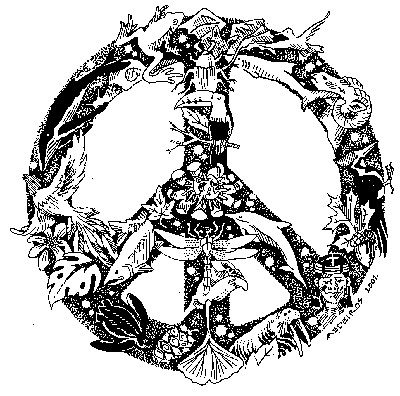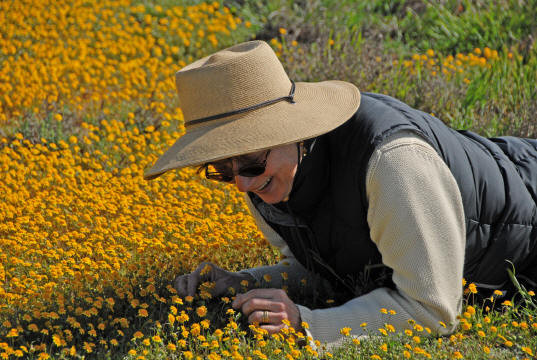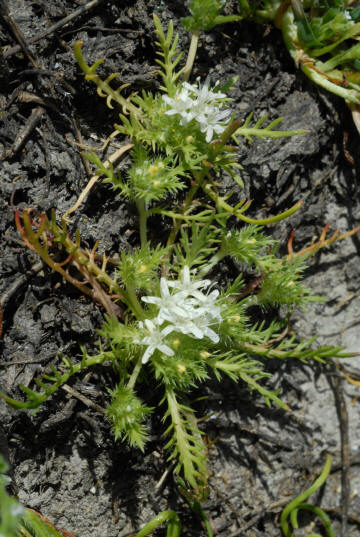


Living Lightly
![]()
44. Microcosmos
I am reading the March/April 2008 issue of Orion magazine, when I come across Matt Jenkins’ article about California’s native bees, “The Headbonkers’ Ball.” Native bees are little appreciated, intricately designed, solitary field laborers, and there are 1500 species in our state. The “headbonkers” in the title of Jenkins’ article refers to Anthidium maculosum, a California native bee that is “fiercely territorial” and will bonk an intruder, usually honeybees but sometimes even researchers, right out of its zone. A little pugnacious, to be sure, but “viewed close while gently held between two fingers, headbonkers are striking creatures,” writes Jenkins, “tiny knots of concentrated metabolism. Their eyes reveal themselves to be entrancing pools of green, prismatic fire.” Other native bees can be a metallic green all over (Agapostemon texanus) or have what Jenkins calls “a risqué penchant for group sleepovers in cosmos flowers [the Melissodes genus].”
 Jenkins devotes his
article to native bees and to Gordon Frankie, a University of California
entomologist who helps people design urban gardens to enhance native bee
populations. When the article mentions Xylocopa varipuncta, a species of
native bee “whose males look uncannily like thimble-sized teddy bears,” I become
a captive reader because I know this bee well from my backyard. Xylo, the
teddy bear bee, does a funny little zigzaggy oh boy oh boy oh boy Yogi-the-Bear
dance at each bloom, as if he were excited that there is yet another one. He
also makes a lot of noise while he nuzzles, so you can’t miss him. I have
wondered about this bee and another I call a “biker bee” (clad in lots of black
leather) because they make the biggest ruckus and are fun to watch because of
their size, weight and antics.
Jenkins devotes his
article to native bees and to Gordon Frankie, a University of California
entomologist who helps people design urban gardens to enhance native bee
populations. When the article mentions Xylocopa varipuncta, a species of
native bee “whose males look uncannily like thimble-sized teddy bears,” I become
a captive reader because I know this bee well from my backyard. Xylo, the
teddy bear bee, does a funny little zigzaggy oh boy oh boy oh boy Yogi-the-Bear
dance at each bloom, as if he were excited that there is yet another one. He
also makes a lot of noise while he nuzzles, so you can’t miss him. I have
wondered about this bee and another I call a “biker bee” (clad in lots of black
leather) because they make the biggest ruckus and are fun to watch because of
their size, weight and antics.
Recently I watched a native bee with beautiful black markings visit one tiny coral bell after another, stuffing the pollen into the pollen sacs on its back legs. I am lucky to be able to have many native (and some non-native) plants, and these plants are where the bees do their early spring work. What
I have discovered, however, is that the native pollinators also move into the fruit trees and other food plants, so there is never a lack of pollination, and natives and non-natives enhance one another.
The work Frankie and his researchers are doing in the bee gardens of Berkeley is important, not just because native bees are as fascinating as birds to watch up close, but because Colony Collapse Disorder, which decimated imported European honeybee populations, pointed out how vulnerable Central Valley agriculture is to monocultural pollinator populations, that is, bees in boxes transported thousands of miles, in some cases, from one orchard or field to another. Frankie realized that there were more native bees finding refuge in urban gardens than on agricultural lands, and this realization led him to become a promoter of native bee gardens.
California’s native bees are attracted to specific plants, and are “six times more likely to visit the native plants with which they have evolved,” according to researchers. The relationships are so specific that bee watchers can predict which plants will attract which bee. Native bees relish various native sages, California poppies, buckwheats, desert willows, linaria, encelia and coreopsis, to name just a few.
 Native bees have a life span
of three to four weeks and are solitary ground-nesters deterred by turf or
mulch, so it is a good idea to leave some bare patches for them. The female bee
hollows out brood cells in the dirt, makes “pollen loaves” or “bee bread” to
tuck into each cavity, deposits her egg, seals the chamber off, and moves on.
The bee bread provides concentrated amounts of vitamins, proteins, fats and
oils, according to Jenkins, and the larvae may feed on the pollen loaf in the
brood chamber for an entire year before warm weather draws them out to continue
the cycle as bees.
Native bees have a life span
of three to four weeks and are solitary ground-nesters deterred by turf or
mulch, so it is a good idea to leave some bare patches for them. The female bee
hollows out brood cells in the dirt, makes “pollen loaves” or “bee bread” to
tuck into each cavity, deposits her egg, seals the chamber off, and moves on.
The bee bread provides concentrated amounts of vitamins, proteins, fats and
oils, according to Jenkins, and the larvae may feed on the pollen loaf in the
brood chamber for an entire year before warm weather draws them out to continue
the cycle as bees.
The Orion article, lovely in its championing of native bees and native plants, reminded me of all the times I have gotten a jolt of pleasure from something tiny in nature, some roving spirit composed of feathers and hollow bones, fur and a buzz, radiant wings and a sting. On the last Oak Apple Nature walk in early April, La Loma children brought me ladybugs, stink bugs and slug bugs; cottonwood pods, oak catkins, urchin galls; and endless numbers of oak apple galls and decaying acorns to examine for larvae and (non-stinging) wasps. We celebrated aphids, midges, and gnats.
The following Sunday biologists Lynn Hansen and Richard Anderson and I spent a lot of time on our hands and knees breathing in the sweet air of vernal pool flowers--goldfields, lupine, navarettia, dodder, downingia, woolly marbles, popcorn flowers--most of them no bigger than a baby’s thumb. Lynn recalled lying in a pool of periwinkle hued downingia, the entire world drowned out by the hum of hundreds of native bees--calling it a peak experience, right up there with sighting albatrosses in Antarctica. Richard found a round, lipped depression in the clay, and we declared this spot in Grasslands State Park omphalos, the bellybutton of the world.
Human beings love the diminutive. There are those who derive bottomless pleasure from assembling model train sets, dollhouses, or small sailboats they can race across a pond. But none of these toys can match the microcosmic ecstasies of the driving fuse, autonomous will, animating spark we encounter in something very small and very alive, going about its work in the world.
ACTION: Visit Gordon Frankie’s lively and instructive native bee website to learn more about native bees and how to make your urban garden a pollinator paradise (http://nature.berkeley.edu/urbanbeegardens).
Sources: Matt Jenkins, “The Headbonkers Ball” in Orion, March/April 2008.
![]()

![]()
In California, more than 30,000 types of insects are known. In spring, it may
seem that most of them are in your backyard. This is because warm temperatures
are ideal for many insect lifecycles. After just a few warm days, large
populations can hatch and inhabit fruit trees, shrubs and vegetable beds.
Aphids, for example, may seem to multiply overnight. Hoplia beetles are another
insect frequently seen in the garden, especially on light colored roses.
While trying to eliminate these pests from your garden, remember that other
insects live there too, and frequently consume insect pests. The use of
insecticides, even organic ones, may have a negative impact on beneficials.
Always read labels carefully, and avoid spraying when beneficial insects such as
honeybees are active.
The number of destructive insects in general is actually quite small in
comparison with those that are beneficial or neutral. Beneficial insects eat
pests, pollinate crops and decompose waste material. These insects include
ladybugs, preying mantids, spiders, assassin bugs, and ground beetles.
Beneficial insects feed in two ways: predation or parasitism. Predation is the
method most gardeners are familiar with, the typical ladybug eating an aphid.
Parasitism is not as easy to spot. To find an example, observe that same
population of aphids, but look closer. If you see small, round, papery-thin
objects with a tiny hole, you’ve spotted an example of parasitism. This remnant
was actually an aphid, and is now known as a “mummy.” When it was alive, this
aphid was parasitized by a tiny wasp (not the same kind that inflicts a painful
sting). The wasp laid an egg inside the aphid, the egg hatched, fed on the aphid
from inside, and then crawled out, leaving a small exit hole. To see an example
of parasitized aphids, go to the UC IPM website online at:
http://www.ipm.ucdavis.edu/PMG/M/I-HO-MPER-AM.001.html
Spiders are another creature commonly found in the garden, and sometimes the
house. They are not considered insects, but are classed as arachnids. Spiders
are excellent predators and can be very helpful in the garden. Two “spiders”
that are often confused are the harvestman (not a true spider) and the cellar
spider. To see photos go to
http://www.flickr.com/photos/tr33lo/209901246/ and
http://www.life.uiuc.edu/ib/109/Insect%20rearing/photos/cellar%20spider.jpg
Both of these creatures are reputed to have poisonous venom, which is not true.
The harvestman does not have venom, and the cellar spider’s venom is harmless to
humans.
ACTION: I will teach a basic entomology class for teachers and school garden
coordinators on Monday, June 16, 2008 from 8:30 am to noon at the Stanislaus
County Ag Center, corner of Service and Crows Landing Roads in Modesto in the
Stanislaus Building, Rooms H & I, I. The cost of the Class cost is $10 for
materials and a light breakfast. Sign up at:
http://cestanislaus.ucdavis.edu/Gardening/Offered_Classes.htm. Or e-mail me
for information at
aschellman@ucdavis.edu
![]()
Garden Journals
By ANNE SCHELLMAN
Horticulture Associate
UC Davis Cooperative Extension
Growing vegetables is hard work, and should not be attempted by couch potatoes, according to Robert Norris, a retired weed science professor from UC Davis. Norris has been gardening in the Central Valley for over 30 years, and through trial and error, has discovered many valuable insights. I had the opportunity to hear him speak in Stockton this past week.
What impressed me most about Norris’ presentation was that it was based on his garden journal. Every year he recorded planted varieties’ success and failure rates. He even kept track of how many pounds of vegetables harvested from each plant to help him determine the most productive varieties.
During his speech he made this interesting statement: “There is no such thing as a bad tomato year.” Norris noted that when many gardeners report low quantities of tomatoes harvested, tomato farmers never seem to have this problem. Why? “Farmers know which varieties to plant, while home gardeners are planting the wrong kinds of tomato.
When a tomato plant fails to “set”, the blossom drops off instead of developing into a fruit. As a horticulturist, I (the author) tell people this has to do with temperature fluctuations. During cold weather, a gardener can spray blossoms with a fruit setting hormone to prevent blossom drop; however, nothing can be done to prevent a tomato plant from dropping flowers when daytime temperatures exceed 92°F.
Norris has yet to have a bad crop of tomatoes, because he chooses varieties that have the ability to set fruit in hot weather, the most critical factor for ensuring a good harvest. Most heirloom varieties do not have this ability, which is why success with fruit set may be spotty.
Norris has had success with varieties such as Big Beef, Burpee 4th of July and Park’s Whopper. Local nurseries and garden centers also carry tomatoes successful in our area, such as Better Boy, Early Girl and Ace. Norris also mentioned that he only chooses tomato varieties with the acronyms VFNT or at least VFN in the name. This is because tomatoes are susceptible to verticillium and fusarium wilt, nematodes and the tobacco mosaic virus. Varieties with the mentioned acronyms are resistant to these problems.
None of Robert Norris’ work is University researched material, it’s simply information he has learned over his lifetime. He noted that it would be difficult for him to remember past gardening experience without the reference of his garden journal.
It’s easy to get stuck on a certain variety. For example my favorite, the heirloom tomato Brandywine. It tastes like it has been salted and is extremely juicy. Unfortunately, in certain years I have limited success in getting fruit set. So although I haven’t given up on Brandywine, I plant plenty of other varieties to ensure my summer garden is complete.
![]()
Lonely garden looking for its soil mate
By MARTHA STALP
Personal Ad: Lonely garden looking for its soil mate.
Wanted: Loving, committed soil mates to reach out and touch me!
Who Am I? a seed never sown; a seedling never planted; a vision of loveliness elusive and unfulfilled. I am a garden waiting to be tended, cared for, loved.
Where Am I? I exist in the strangest locales: Downey High School, Beard and El Vista Elementary Schools and other school settings. I am soft as the softest dew at Downey I am scrabble scruff like a Beard. Yet I reach out to higher El Vistas.
Be of brave heart. Become my volunteer soil mate. Connect with me at 578-5097. Be assured my lonely garden needs your TLC.
![]()
